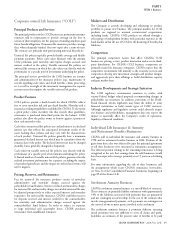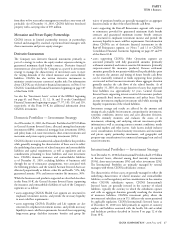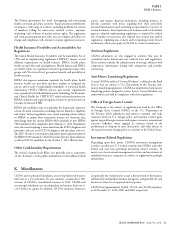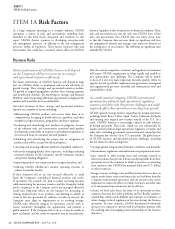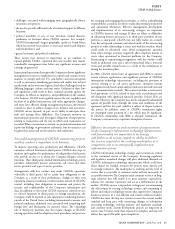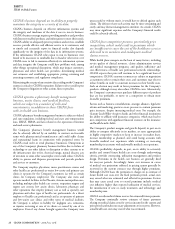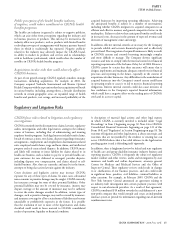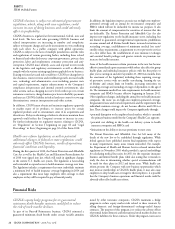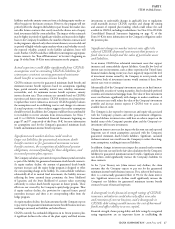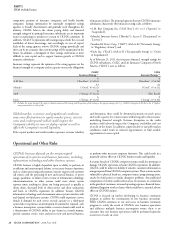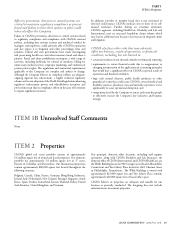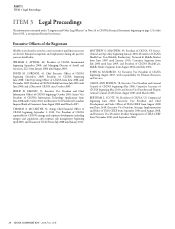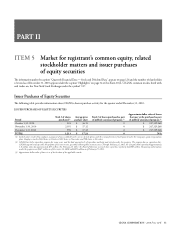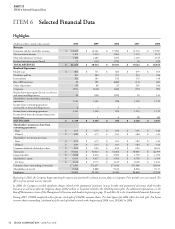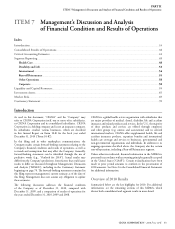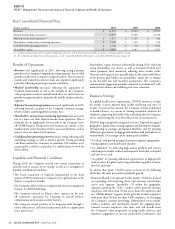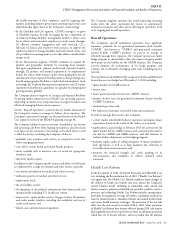Cigna 2010 Annual Report Download - page 45
Download and view the complete annual report
Please find page 45 of the 2010 Cigna annual report below. You can navigate through the pages in the report by either clicking on the pages listed below, or by using the keyword search tool below to find specific information within the annual report.
CIGNA CORPORATION 2010 Form 10K 25
PARTI
ITEM 1A Risk Factors
Public perception of the health benefi ts industry,
if negative, could reduce enrollment in CIGNA’s health
benefi ts programs.
e health care industry in general is subject to negative publicity,
which can arise either from perceptions regarding the industry and
its business practices or products. is risk may be increased as the
industry off ers new products, such as products with limited benefi ts
or develops new types of arrangements with business partners beyond
those in which it traditionally has operated. Negative publicity
related to the industry may adversely impact the CIGNA brand,
its ability to market its products and services and its relationships
with its healthcare professionals, which could reduce the number of
enrollees in CIGNA’s health benefi ts programs.
Acquisitions involve risks that could adversely aff ect
CIGNA’s business.
As part of our growth strategy, CIGNA regularly considers strategic
transactions, including acquisitions. For example, in 2010, the
Company acquired Vanbreda International and Kronos Optimal
Health Company with the expectation that these acquisitions will result
in various benefi ts, including, among others, a broader distribution
network in certain geographic areas, an expanded range of health
benefi ts and products, cost savings, and increased profi tability of the
acquired businesses by improving operating effi ciencies. Achieving
the anticipated benefi ts is subject to a number of uncertainties,
including whether CIGNA integrates its acquired companies in an
effi cient and eff ective manner, and general competitive factors in the
marketplace. Failure to achieve these anticipated benefi ts could result
in increased costs, decreases in the amount of expected revenues and
diversion of management’s time and energy.
In addition, eff ective internal controls are necessary for the Company
to provide reliable and accurate fi nancial reports and to eff ectively
prevent fraud. e integration of acquired businesses is likely to result
in CIGNA’s systems and controls becoming increasingly complex
and more diffi cult to manage. e Company devotes signifi cant
resources and time to comply with the internal control over fi nancial
reporting requirements of the Sarbanes-Oxley Act of 2002. However,
CIGNA cannot be certain that these measures will ensure that it
designs, implements and maintains adequate control over its fi nancial
processes and reporting in the future, especially in the context of
acquisitions of other businesses. Any diffi culties in the assimilation of
acquired businesses into the Company’s control system could harm
its operating results or cause it to fail to meet its fi nancial reporting
obligations. Inferior internal controls could also cause investors to
lose confi dence in the Company’s reported fi nancial information,
which could have a negative eff ect on the trading price of CIGNA’s
stock and its access to capital.
Regulatory and Litigation Risks
CIGNA faces risks related to litigation and regulatory
investigations.
CIGNA is routinely involved in numerous claims, lawsuits, regulatory
audits, investigations and other legal matters arising in the ordinary
course of business, including that of administering and insuring
employee benefi t programs. Such legal matters include benefi t claims,
breach of contract actions, tort claims, disputes regarding reinsurance
arrangements, employment and employment discrimination-related
suits, employee benefi t claims, wage and hour claims, and intellectual
property and real estate related disputes. In addition, CIGNA incurs
and likely will continue to incur liability for claims related to its
health care business, such as failure to pay for or provide health care,
poor outcomes for care delivered or arranged, provider disputes,
including disputes over compensation, and claims related to self-
funded business. Also, there are currently, and may be in the future,
attempts to bring class action lawsuits against the industry.
Court decisions and legislative activity may increase CIGNA’s
exposure for any of these types of claims. In some cases, substantial
non-economic or punitive damages may be sought. CIGNA currently
has insurance coverage for some of these potential liabilities. Other
potential liabilities may not be covered by insurance, insurers may
dispute coverage or the amount of insurance may not be suffi cient
to cover the entire damages awarded. In addition, certain types of
damages, such as punitive damages, may not be covered by insurance,
and insurance coverage for all or certain forms of liability may become
unavailable or prohibitively expensive in the future. It is possible
that the resolution of one or more of the legal matters and claims
described could result in losses material to CIGNA’s consolidated
results of operations, liquidity or fi nancial condition.
A description of material legal actions and other legal matters
in which CIGNA is currently involved is included under “Legal
Proceedings” in Item 3 beginning on page 30, Note 24 to CIGNA’s
Consolidated Financial Statements beginning on page 121 of this
Form 10-K and “Regulation” in Section J beginning on page 18. e
outcome of litigation and other legal matters is always uncertain, and
outcomes that are not justifi ed by the evidence or existing law can
occur. CIGNA believes that it has valid defenses to the legal matters
pending against it and is defending itself vigorously.
In addition, there is heightened review by federal and state regulators
of health care and group disability insurance industry business and
reporting practices. CIGNA is frequently the subject of regulatory
market conduct and other reviews, audits and investigations by state
insurance and health and welfare departments, attorneys general,
Centers for Medicare and Medicaid Services and, the Offi ce of
Inspector General. ese regulatory reviews could result in changes
to or clarifi cations of our business practices, and also could result
in signifi cant fi nes, penalties, civil liabilities, criminal liabilities or
other sanctions. For example, in February 2009, CIGNA and the
New York Attorney General announced an agreement relating to
an industry-wide investigation into certain payment practices with
respect to out-of-network providers. As a result of that agreement,
CIGNA contributed $10 million towards the establishment of a new
non-profi t company that would compile and create an independent
database system to provide fee information regarding out-of-network
reimbursement rates.


